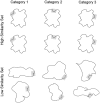Effects of interleaved and blocked study on delayed test of category learning generalization
- PMID: 25202296
- PMCID: PMC4141442
- DOI: 10.3389/fpsyg.2014.00936
Effects of interleaved and blocked study on delayed test of category learning generalization
Abstract
Studying different concepts by frequently alternating between them (i.e., interleaving), improves discriminative contrast between different categories, while studying each concept in separate blocks emphasizes the similarities within each category. Interleaved study has been shown to improve learning of high similarity categories by increasing between-category comparison, while blocked study improves learning of low similarity categories by increasing within-category comparison. In addition, interleaved study presents greater temporal spacing between repetitions of each category compared to blocked study, which might present long-term memory benefits. In this study we asked if the benefits of temporal spacing would interact with the benefits of sequencing for making comparisons when testing was delayed, particularly for low similarity categories. Blocked study might be predicted to promote noticing similarities across members of the same category and result in short-term benefits. However, the increase in temporal delay between repetitions inherent to interleaved study might benefit both types of categories when tested after a longer retention interval. Participants studied categories either interleaved or blocked and were tested immediately and 24 h after study. We found an interaction between schedule of study and the type of category studied, which is consistent with the differential emphasis promoted by each sequential schedule. However, increasing the retention interval did not modulate this interaction or resulted in improved performance for interleaved study. Overall, this indicates that the benefit of interleaving is not primarily due to temporal spacing during study, but rather due to the cross-category comparisons that interleaving facilitates. We discuss the benefits of temporal spacing of repetitions in the context of sequential study and how it can be integrated with the attentional bias hypothesis proposed by Carvalho and Goldstone (2014a).
Keywords: blocking; category learning; comparison; interleaving; spacing.
Figures





Similar articles
-
Putting category learning in order: Category structure and temporal arrangement affect the benefit of interleaved over blocked study.Mem Cognit. 2014 Apr;42(3):481-95. doi: 10.3758/s13421-013-0371-0. Mem Cognit. 2014. PMID: 24092426
-
The benefits of interleaved and blocked study: different tasks benefit from different schedules of study.Psychon Bull Rev. 2015 Feb;22(1):281-8. doi: 10.3758/s13423-014-0676-4. Psychon Bull Rev. 2015. PMID: 24984923
-
The benefit of interleaved presentation in category learning is independent of working memory.Memory. 2020 Feb;28(2):285-292. doi: 10.1080/09658211.2019.1705490. Epub 2020 Jan 3. Memory. 2020. PMID: 31900048
-
What you learn is more than what you see: what can sequencing effects tell us about inductive category learning?Front Psychol. 2015 Apr 30;6:505. doi: 10.3389/fpsyg.2015.00505. eCollection 2015. Front Psychol. 2015. PMID: 25983699 Free PMC article. Review.
-
Visual category learning: Navigating the intersection of rules and similarity.Psychon Bull Rev. 2021 Jun;28(3):711-731. doi: 10.3758/s13423-020-01838-0. Epub 2021 Jan 19. Psychon Bull Rev. 2021. PMID: 33464550 Review.
Cited by
-
Auditory category learning is robust across training regimes.Cognition. 2023 Aug;237:105467. doi: 10.1016/j.cognition.2023.105467. Epub 2023 May 4. Cognition. 2023. PMID: 37148640 Free PMC article.
-
Whether Interleaving or Blocking Is More Effective for Long-Term Learning Depends on One's Learning Strategy.Behav Sci (Basel). 2025 May 12;15(5):662. doi: 10.3390/bs15050662. Behav Sci (Basel). 2025. PMID: 40426440 Free PMC article.
-
Feature saliency and feedback information interactively impact visual category learning.Front Psychol. 2015 Feb 19;6:74. doi: 10.3389/fpsyg.2015.00074. eCollection 2015. Front Psychol. 2015. PMID: 25745404 Free PMC article.
-
Reward Learning over Weeks Versus Minutes Increases the Neural Representation of Value in the Human Brain.J Neurosci. 2018 Aug 29;38(35):7649-7666. doi: 10.1523/JNEUROSCI.0075-18.2018. Epub 2018 Jul 30. J Neurosci. 2018. PMID: 30061189 Free PMC article.
-
Familiar Strategies Feel Fluent: The Role of Study Strategy Familiarity in the Misinterpreted-Effort Model of Self-Regulated Learning.J Intell. 2022 Oct 12;10(4):83. doi: 10.3390/jintelligence10040083. J Intell. 2022. PMID: 36278605 Free PMC article.
References
LinkOut - more resources
Full Text Sources
Other Literature Sources

